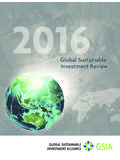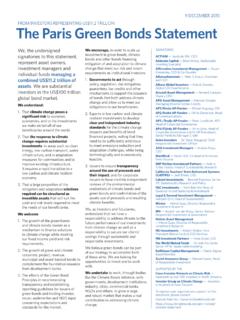Transcription of Sustainable financing for forest and landscape restoration
1 Sustainable financing for forest and landscape restoration OPPORTUNITIES, CHALLENGES. AND THE WAY FORWARD. 101. Sustainable financing for forest and landscape restoration OPPORTUNITIES, CHALLENGES. AND THE WAY FORWARD. UNITED NATIONS CONVENTION TO COMBAT DESERTIFICATION. FOOD AND AGRICULTURE ORGANIZATION OF THE UNITED NATIONS. Rome, 2015. The designations employed and the presentation of material in this information product do not imply the expression of any opinion whatsoever on the part of the Food and Agriculture Organization of the United Nations (FAO) or of the United Nations Convention to Combat Desertification (UNCCD) concerning the legal or development status of any country, territory, city or area or of its authorities, or concerning the delimitation of its frontiers or boundaries. The mention of specific companies or products of manufacturers, whether or not these have been patented, does not imply that these have been endorsed or recommended by FAO or UNCCD in preference to others of a similar nature that are not mentioned.
2 The views expressed in this information product are those of the author(s) and do not necessarily reflect the views or policies of FAO or UNCCD. FAO and UNCCD encourage the use, reproduction and dissemination of material in this information product. Except where otherwise indicated, material may be copied, downloaded and printed for private study, research and teaching purposes, or for use in non-commercial products or services, provided that appropriate acknowledgement of FAO and UNCCD as the source and copyright holder is given and that either FAO's or UNCCD's endorsement of users' views, products or services is not implied in any way. All requests for translation and adaptation rights and for resale and other commercial use rights should be made via or addressed to FAO information products are available on the FAO Web site ( ) and can be purchased through UNCCD.
3 Information products are available on the UNCCD Web site ( ) and can be requested through ISBN 978-92-5-108992-7 (FAO). FAO and UNCCD, 2015. Authors and writing committee Lead author: Ludwig Liagre (Global Mechanism-UNCCD). Publication coordinator: Pedro Lara Almuedo (Global Mechanism-UNCCD). Contributing authors: Christophe Besacier (FAO), Michela Conigliaro (FAO), Pedro Lara Almuedo (Global Mechanism-UNCCD). Writing committee: Douglas McGuire (FAO), Christophe Besacier (FAO), Rao Matta (FAO), Sven Walter (Global Mechanism-UNCCD), Pedro Lara Almuedo (Global Mechanism-UNCCD), Ludwig Liagre (Global Mechanism- UNCCD), Michela Conigliaro (FAO), Bom Kwon Chun (FAO), Sue Lee (FAO). This publication is available for download at and Citation: FAO & Global Mechanism of the UNCCD. 2015. Sustainable financing for forest and landscape restoration : Opportunities, challenges and the way forward.
4 Discussion paper. Rome. ii Contents Foreword ix Acknowledgements x Acronyms xi Executive Summary xiii Part 1. Background 1. 1. Overview 3. High goals and expectations for FLR 5. Synergies between FLR and climate-smart landscapes 6. About this discussion paper 6. 2. Costs and benefits of FLR 9. The cost of landscape degradation 9. Funding needed for FLR 9. Benefits of FLR 10. Potential FLR benefits in drylands 11. Additional benefits of FLR: disaster risk reduction and adaptation to climate change 12. FLR: a key for an inclusive green economy 12. 3. financing for FLR: an introduction 15. Synergies with other land-use and environmental finance streams 15. Who will pay for FLR? 15. Three investment steps 17. Types of investors and expected returns on investments 18. Types of capital 18. A mix of funding sources 21. Part 2: Funding sources and instruments for forest and landscape restoration 25.
5 4. Climate financing instruments 27. Mitigation-based financing instruments 27. Adaptation-based financing instruments 30. Instruments that bridge the gap between adaptation and mitigation: adaptation-based mitigation 32. Towards an optimal use of climate financing instruments for FLR 32. Key messages on climate finance instruments and FLR 33. 5. Development banks and international agencies 35. Magnitude of potential support to FLR 35. A variety of financing tools: loans, grants, guarantees, debt relief 36. Innovative development cooperation approaches: South South and triangular cooperation 37. Measures to promote development cooperation funding for FLR 37. iii 6. Environmental funds 39. Global scope 39. Regional scope 40. National scope 40. Local scope 42. Key messages on environmental funds and FLR 42. 7. Non-governmental organizations 43. International civil society organizations 43.
6 National civil society organizations 45. Sources of financing for local civil society organizations 45. Key messages on non-governmental funding and FLR 47. 8. National budgets and resources 49. Raising awareness of FLR at the national level 49. National and subnational budgets for FLR 50. Creating an enabling environment for increased public finance for FLR 51. Key messages on state funding and FLR 53. 9. Private sector engagement 55. landscapes and corporate social responsibility: no direct financial returns expected 55. landscapes for Sustainable business: direct financial returns expected 58. Payments for ecosystem services and restoration bonds 60. Key messages on private sector funding 61. 10. Non-traditional or innovative funding for FLR 63. Crowdfunding for FLR: federating and involving citizens 63. Green bank cards: turning the money saver into a good-doer 65.
7 Key messages on non traditional funding mechanisms 66. Part 3: Improving investment in forest and landscape restoration 67. 11. Identification of priority areas for FLR investment 69. Assessing opportunities for FLR 69. Type of landscape to be restored 71. Country priorities and local restoration opportunities 71. Viability of the FLR intervention 73. 12. Creating an enabling environment for FLR investments 75. Ensuring a favourable investment climate 75. Building landscape readiness for investment 77. Raising awareness of investors and project promoters and implementers 78. Securing investments and mitigating risks 80. 13. Building and strengthening alliances 85. Building on existing platforms 85. Combining local, regional and global levels in platforms and alliances 88. 14. The way forward 91. Thinking out of the box to make it happen 91. Partnerships: no need to reinvent the wheel, just get it rolling 91.
8 Iv Capacity development: the best value for money 91. Marketplaces for FLR investments 92. The decisive role of governments 92. Private sector, the missing piece 92. The donor community: responsible for facilitating transformation? 93. Citizens and individuals: a driving force for long-term change 93. References 95. Annexes 101. Annex 1: Estimated costs and benefits of restoration projects in different biomes 102. Annex 2: Interactions between financing sources 103. Annex 3: Key development cooperation financing institutions 104. Annex 4: Examples of FLR-relevant environmental funds with different geographical scope 105. Annex 5: Examples of FLR initiatives financed by or through national civil society organizations 107. Annex 6: Private equity impact funds involved in FLR 108. Annex 7: Some information resources, tools and guidelines on FLR 110.
9 Annex 8: Initiatives related to the economics of ecosystems 114. v Figures, tables and boxes FIGURES. Figure 1 Wide-scale schematic representation of mosaic restoration opportunities 5. Figure 2 How FLR contributes to strategies to address climate change impacts 6. Figure 3 Possible benefit-cost ratio of restoring natural ecosystems 11. Figure 4 Mean value of drylands 11. Figure 5 FLR finance: a mosaic of financing streams 15. Figure 6 Bridging the gap: investors and FLR costs and benefits 15. Figure 7 Different asset types and economic instruments required for the three steps of FLR investment 22. Figure 8 Mix of financing sources required for FLR 22. Figure 9 Different investors expect different returns 23. Figure 10 Interconnections among financing sources: the example of finance originating from development cooperation 23. Figure 11 forest ecosystem-based adaptation 31.
10 Figure 12 National climate fund model: mobilizing funds for both adaptation and mitigation 33. Figure 13 Land Degradation Neutrality Fund investment model 41. Figure 14 Land Degradation Neutrality Fund structure 41. Figure 15 Different uses of financing for fruitful collaboration among the three levels of civil society organizations 46. Figure 16 FLR: relevant to five fields of CSR and seven related indicators 55. Figure 17 Potential for resource mobilization among different types of CSR strategies for support to FLR where no direct financial return is expected 56. Figure 18 Sustainability-related impact investments by high-net-worth individuals 59. Figure 19 The Rainforest Impact Bond: a possible model for a restoration bond programme 62. Figure 20 Green card feeding the Sustainable Biodiversity Fund in Costa Rica 65. Figure 21 Ecological integrity of restored or rehabilitated ecosystems and human well-being 69.















